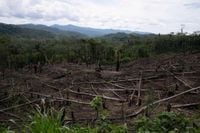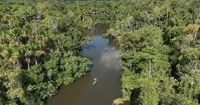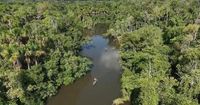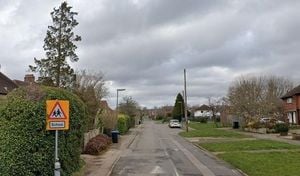High above the dense green canopy of the Amazon, invisible highways of moisture—known as "flying rivers"—are quietly shaping the fate of South America. These aerial streams, carrying vast quantities of water vapor from the Atlantic Ocean westward, have long been the lifeblood of the rainforest, sustaining not just the trees and wildlife below but also the millions of people who depend on the Amazon’s seasonal rhythms. Now, scientists warn, these flying rivers are under threat, and the consequences could be dire for the forest, its inhabitants, and the planet at large.
According to a recent analysis reported by the Associated Press, relentless deforestation and climate change are disrupting the flow of these vital moisture currents. "These are the forces that actually create and sustain the Amazon rainforest," explained Matt Finer, a senior researcher with Amazon Conservation’s Monitoring of the Andean Amazon Project (MAAP), which tracks deforestation and climate threats across the basin. "If you break that pump by cutting down too much forest, the rains stop reaching where they need to go."
The science behind flying rivers is surprisingly elegant. Most of the Amazon’s rainfall starts as moist air over the Atlantic, pushed inland by steady trade winds. Once this air mass reaches the forest, the trees act like a colossal pump: they absorb water through their roots and release it back into the atmosphere via transpiration. This process relays moisture thousands of miles across the continent, feeding rainfall cycles as far as the Andes. Brazilian climate scientist Carlos Nobre, one of the early researchers to quantify this process, helped coin the "flying rivers" term at a 2006 scientific meeting. Since then, the concept has become central to understanding the Amazon’s fragility in the face of environmental change.
But the pump is faltering. Unchecked deforestation—especially in Brazil, where highways and farms carve ever-deeper into the forest—has begun to sever the links in this atmospheric chain. The result? Less water vapor is carried westward, raising the risk of drought in regions that rely on the Amazon’s rain. The Associated Press reports that southern Peru and northern Bolivia are especially vulnerable. During the dry season, flying rivers sweep across southern Brazil before reaching the Andes—precisely where deforestation is most intense. "Peru can do everything right to protect a place like Manu [National Park]," Finer said. "But if deforestation keeps cutting into the pump in Brazil, the rains that sustain it may never arrive."
The consequences are already being felt. Droughts have withered crops in Peru, fires have scorched the Amazon, and hydroelectric dams in Ecuador have struggled as rivers dry up. Corine Vriesendorp, director of science at Conservacion Amazonica in Cusco, Peru, noted, "The last two years have brought the driest conditions the Amazon has ever seen. Ecological calendars that Indigenous communities use—when to plant, when to fish, when animals reproduce—are increasingly out of sync. Having less and more unpredictable rain will have an even bigger impact on their lives than climate change is already having."
It’s not just rural communities that are at risk. Cities that rely on hydroelectric power face outages as river levels fall, and the ripple effects could extend to global climate stability. The Amazon rainforest is one of the world’s largest carbon sinks, storing enormous amounts of carbon dioxide. If the forest tips toward a drier, savanna-like ecosystem, vast amounts of stored carbon could be released, accelerating global warming.
The warning signs are clear. The Amazon’s dry season is now five weeks longer than it was 45 years ago, with 20 to 30% less rainfall, according to Nobre. The forest has already lost about 17% of its cover, mostly to cattle and soy farming. Scientists warn that if deforestation exceeds 20 to 25% and warming reaches 2 degrees Celsius, the Amazon could reach a tipping point—an irreversible shift from rainforest to savanna. "If deforestation exceeds 20 to 25% and warming reaches 2 degrees Celsius, there’s no way to prevent the Amazon from reaching the tipping point," Nobre cautioned.
Researchers are urging immediate action. Protecting intact forests, supporting Indigenous land rights, and restoring deforested areas are seen as the clearest paths forward. "To avoid collapse we need zero deforestation, degradation and fires—immediately," Nobre said. "And we must begin large-scale forest restoration, not less than half a million square kilometers. If we do that, and keep global warming below 2 degrees, we can still save the Amazon."
Finer emphasized that governments should consider new conservation categories specifically designed to protect flying rivers—not just the land, but the atmospheric flows that make the rainforest possible. This means recognizing the Amazon as a system that transcends national borders. "This can’t be solved by one country alone. Peru depends on Brazil, and Brazil depends on its neighbors. We need basin-wide solutions," Vriesendorp stressed.
Regional cooperation is emerging as a central theme in the fight to preserve the Amazon’s flying rivers. The Amazon basin spans multiple countries, including Brazil, Peru, and Bolivia, each with its own challenges and priorities. While Peru has created vast parks and Indigenous reserves in the southeast, researchers warn that these efforts could be undone if neighboring countries fail to curb deforestation. Roads, like Brazil’s controversial BR-319 highway, threaten to open new fronts of forest loss, further weakening the flying rivers during the critical dry season when the forest most needs water.
The stakes could hardly be higher. The disruption of flying rivers threatens not only the Amazon’s extraordinary biodiversity and the cultures of its Indigenous peoples but also the stability of weather and water supplies far beyond the region. Farming, fishing, and hydroelectric power—all depend on the regular pulse of rain that the flying rivers deliver. As the Amazon faces unprecedented drought conditions, the call for coordinated, science-based action grows ever more urgent.
In the face of such daunting challenges, hope persists. Scientists stress that the window for action has not yet closed. Large-scale forest restoration, robust protection of remaining intact forests, and respect for Indigenous stewardship can still tip the balance. But the clock is ticking, and the invisible rivers above the Amazon will not wait forever.
As the region grapples with the consequences of deforestation and climate change, the future of the Amazon—and the world—may well depend on whether these flying rivers continue to flow.






